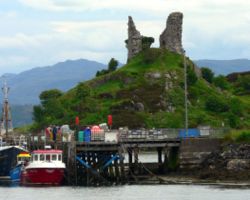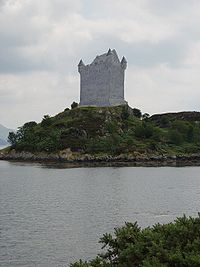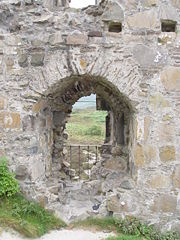
Caisteal Maol
Encyclopedia

Castle
A castle is a type of fortified structure built in Europe and the Middle East during the Middle Ages by European nobility. Scholars debate the scope of the word castle, but usually consider it to be the private fortified residence of a lord or noble...
located near the harbour of the village of Kyleakin
Kyleakin
The village of Kyleakin is situated on the east coast of the Isle of Skye in the Inner Hebrides, along the strait of Kyle Akin opposite the northwest Scottish mainland town of Kyle of Lochalsh...
, Isle of Skye, Scotland
Scotland
Scotland is a country that is part of the United Kingdom. Occupying the northern third of the island of Great Britain, it shares a border with England to the south and is bounded by the North Sea to the east, the Atlantic Ocean to the north and west, and the North Channel and Irish Sea to the...
. It is also known as Castle Moil, Castle Moal, Dun Akyn, Dunakin Castle Dun Haakon and Castle Dunakin.

History
The castle, an ancient seat of the Mackinnon clanClan MacKinnon
Clan Mackinnon or Clan Fingon is a Highland Scottish clan associated with the islands of Mull and Skye, in the Inner Hebrides.Popular tradition gives the clan a Dalriadic Gaelic origin. The 19th century historian W. F. Skene named the clan as one of the seven clans of Siol Alpin - who according to...
, was a fortress commanding the strait
Sound (geography)
In geography a sound or seaway is a large sea or ocean inlet larger than a bay, deeper than a bight and wider than a fjord; or it may be defined as a narrow sea or ocean channel between two bodies of land ....
of Kyle Akin between Skye and the mainland, through which all ships had to pass or else attempt the stormy passage of The Minch
The Minch
The Minch , also called The North Minch, is a strait in north-west Scotland, separating the north-west Highlands, and the northern Inner Hebrides, from Lewis and Harris in the Outer Hebrides...
. The present building dates back to the 15th century, but is traditionally reputed to be of much earlier origin.
According to that tradition, Alpín mac Echdach
Alpín mac Echdach
Alpín mac Eochaid may refer to two persons. The first person is a presumed king of Dál Riata in the late 730s. The second is the father of Kenneth MacAlpin...
's great-grandson Findanus
Findanus
Findanus is claimed by Clan MacKinnon as their fourth chief and the progenitor of the clan name. He was the great grandson of Alpin and is believed to have lived in the late ninth and early tenth centuries on the Isle of Skye, Scotland...
, the 4th MacKinnon
Clan MacKinnon
Clan Mackinnon or Clan Fingon is a Highland Scottish clan associated with the islands of Mull and Skye, in the Inner Hebrides.Popular tradition gives the clan a Dalriadic Gaelic origin. The 19th century historian W. F. Skene named the clan as one of the seven clans of Siol Alpin - who according to...
chief, brought Dunakin into the clan around the year 900 by marrying a Norse princess nicknamed 'Saucy Mary'. Findanus
Findanus
Findanus is claimed by Clan MacKinnon as their fourth chief and the progenitor of the clan name. He was the great grandson of Alpin and is believed to have lived in the late ninth and early tenth centuries on the Isle of Skye, Scotland...
and his bride ran a heavy chain across the sound and levied a toll on all shipping vessels. The Princess lies buried on Beinn na Caillich on Skye, her face reputedly turned towards Norway
Norway
Norway , officially the Kingdom of Norway, is a Nordic unitary constitutional monarchy whose territory comprises the western portion of the Scandinavian Peninsula, Jan Mayen, and the Arctic archipelago of Svalbard and Bouvet Island. Norway has a total area of and a population of about 4.9 million...
.
Whatever the veracity of the castle's traditional history, there is good reason for supposing the existence of a connection of some kind with Norway. King Haakon IV
Haakon IV of Norway
Haakon Haakonarson , also called Haakon the Old, was king of Norway from 1217 to 1263. Under his rule, medieval Norway reached its peak....
is thought to have assembled his fleet of longships there before the Battle of Largs
Battle of Largs
The Battle of Largs was an engagement fought between the armies of Norway and Scotland near the present-day town of Largs in North Ayrshire on the Firth of Clyde in Scotland on 2 October 1263. It was the most important military engagement of the Scottish-Norwegian War. The Norwegian forces were...
in 1263 (hence the name Kyleakin
Kyleakin
The village of Kyleakin is situated on the east coast of the Isle of Skye in the Inner Hebrides, along the strait of Kyle Akin opposite the northwest Scottish mainland town of Kyle of Lochalsh...
- Haakon's kyle). Haakon's defeat there effectively ended Norse domination of the islands. Mediaeval and early modern documents also refer to the castle itself as Dunakin (Dun-Haakon), which is again strongly suggestive of a Norse connection.

Lord of the Isles
The designation Lord of the Isles is today a title of Scottish nobility with historical roots that go back beyond the Kingdom of Scotland. It emerged from a series of hybrid Viking/Gaelic rulers of the west coast and islands of Scotland in the Middle Ages, who wielded sea-power with fleets of...
. The last occupant of the castle was Neill MacKinnon, nephew of 26th chief of the clan (c. 1601)..
Description
The castle occupies a headland above the village of KyleakinKyleakin
The village of Kyleakin is situated on the east coast of the Isle of Skye in the Inner Hebrides, along the strait of Kyle Akin opposite the northwest Scottish mainland town of Kyle of Lochalsh...
facing the village of Kyle of Lochalsh
Kyle of Lochalsh
Kyle of Lochalsh is a village on the northwest coast of Scotland, 63 miles west of Inverness. It is located at the entrance to Loch Alsh, opposite the village of Kyleakin on the Isle of Skye...
across the strait. It is a simple rectangular keep of three stories. The unexplored basement level is filled with rubble and other debris and is believed to have contained the kitchen. The visitor today enters on the main level where the public dining space would have been. Stairs would have led up to the private apartments above.
The castle is nearly completely ruined. In 1949 and 1989 parts of the ruins broke away in storms. The remaining ruins have been secured to prevent further deterioration. No excavation of the ruins has been carried out, or is planned.

